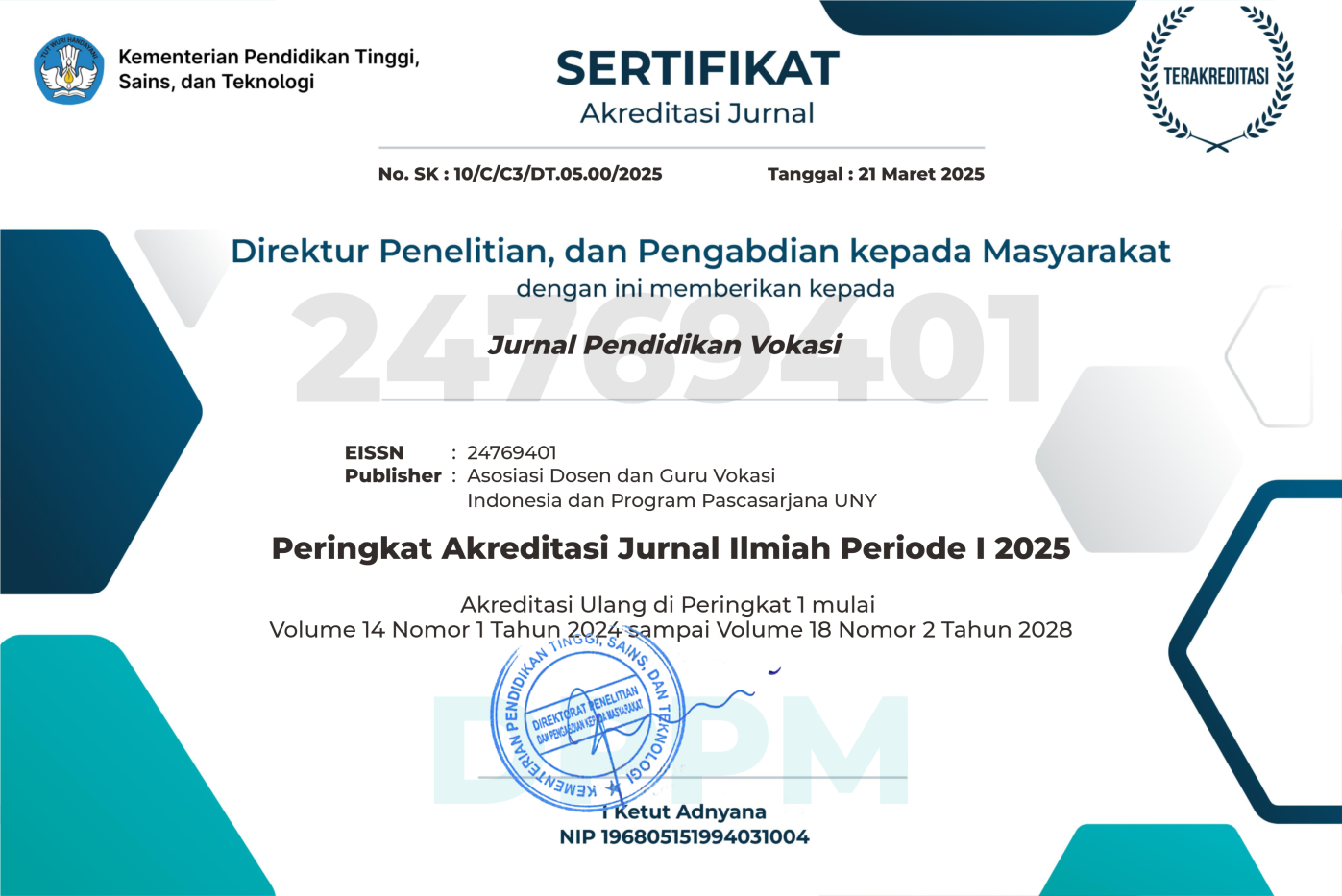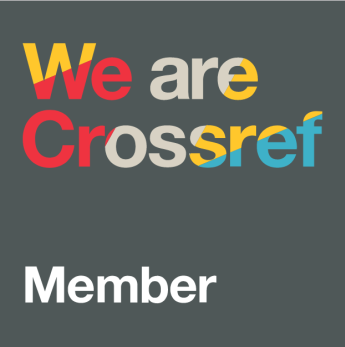The effect of ARIAS learning model on the learning outcomes about continental food processing in Bogor 3 State Vocational Schools from creativity of students
DOI:
https://doi.org/10.21831/jpv.v9i1.22894Keywords:
ARIAS learning model, creativity, learning outcomesAbstract
This study aims to obtain information about: (1) differences in learning outcomes between students who study using the ARIAS learning model and students who learn using direct learning (DL); (2) differences in learning outcomes between students who have high creativity and students who have low creativity; and (3) whether the relationship between the use of learning models and learning outcomes in continental food processing is influenced by students' creativity. This experimental study was conducted using a 2 x 2 factorial design, with the moderator variable being students' creativity. In the experiment, the separation of the level of student creativity was not carried out significantly. Students are called to have high creativity, if they have a score higher or equal to the median group (ian median), while students are called to have low creativity, if they have a score less than or below the median (<median) group. The study was conducted in class XI Hospitality 1 by applying the ARIAS learning model, and class XI Hospitality 2 by applying DL. The study found that: (1) students who studied using the ARIAS learning model obtained significantly higher cognitive, affective and psychomotor learning outcomes than students who studied using DL; (2) students who have high creativity, obtain significantly higher cognitive, affective and psychomotor learning outcomes than students who have low creativity; and (3) the relationship between the use of learning models and learning outcomes in continental food processing is influenced by student creativity.
References
Ambiyar, A., Yulastri, A., Putri, Y. E., & Wulansari, R. E. (2018). An evaluation of students industrial training courses implementation at higher education. Jurnal Pendidikan Vokasi, 8(3), 258. https://doi.org/10.21831/jpv.v8i3.20775
Craft, A. (2004). Membangun kreativitas anak. Depok: Insani Pers.
Hadlock, H., Wells, S., Hall, J., Clifford, J., Winowich, N., & Burns, J. (2008). From practice to entrepreneurship: rethinking the learning factory approach. In IAJC IJME International Conference.
Hernawan, A. H., Susilana, R., Julaeha, S., & Sanjaya, W. (2006). Pengembangan kurikulum dan pembelajaran. Jakarta: Universitas Terbuka.
Hidayat, R., & Patras, Y. E. (2015). Pendidikan Abad 21 dan Kurikulum 2013. Bogor: Universitas Pakuan.
Hindayani, S. (2013). Pengaruh model pembelajaran Arias (Assurance, Relevance, Interst, Assessment dan Satisfaction) terhadap hasil belajar matematika di SD.Skripsi.Universitas Pendidikan Ganesha.
Johnson, E. B. (2014). CTL-Contextual teaching and learning. (I. Setiawan, Trans.). Bandung: Kaifa.
Joyce, B., & Weil, M. (2011). Model of teaching. Model-model pengajaran. (A. Fawaid & A. Mirza, Trans.). Yogyakarta: Pustaka Pelajar.
Marrapodi, J. (2003). Critical thinking and creativity an overview and comparison of the theories. In Partial Fulfillment Of the Requirements of ED7590 Critical Thinking and Adult Education. Providence.
Muslim, S. (2013). Tes Kinerja (performace test) dalam bidang pendidikan teknologi dan kejuruan. In Seminar Teknik Elektro dan Pendidikan Teknik Elektro.
Muslim, S., Gitama, N. P., Suprianto, B., Rahmadyanti, E., & Kusumawati, N. (2018). Influence of learning media based on adobe flash professional to psychomotor domain learning outcomes on plc courses viewed from level of creative thinking student. Jurnal Pendidikan Vokasi, 8(3), 267. https://doi.org/10.21831/jpv.v8i3.21552
Ningsih, K. (2010). Efektivitas model pembelajaran ARIAS berbasis contextual teaching and learning dalam meningkatkan pencapaian kompetensi dasar sains pada siswa SMP Kota Pontianak. Guru Membangun, 24(2).
Praptinasari, S. (2012). Pengaruh penerapan model pembelajaran Assurance, Relevance, Interest, Assesment, and Satisfaction (Arias) terhadap hasil belajar biologi siswa kelas XI IPA SMA Al Islam 1 Surakarta. Skripsi. Pendidikan Biologi FKIP UNS.
Rentzos, L., Doukas, M., Mavrikios, D., Mourtzis, D., & Chryssolouris, G. (2014). Integrating manufacturing education with industrial practice using teaching factory paradigm: a construction equipment application. Procedia CIRP, 17, 189–194. https://doi.org/10.1016/j.procir.2014.01.126
Schunk, D. H. (2012). Learning theories an educational perspektif (teori teori pembelajaran: perspektif pendidikan). (E. Hamdiah & R. Fajar, Trans.). Yogyakarta: Pustaka Pelajar.Sharan, S. (2012). The handbook of cooperative learning. (S. Prawoto, Trans.). Yogyakarta: Familia (Grup Relasi Inti Media).
Silver, E. A. (1997). Fostering creativity throughinstruction rich in mathematical problem solving and problem posing. Zentralblatt Fí¼r Didaktik Der Mathematik, 29(3), 75–80. https://doi.org/10.1007/s11858-997-0003-x
Siswono, T. Y. E. (2008). Model pembelajaran matematika berbasis pengajuan dan pemecahanmasalah untuk meningkatkan kemampuan berpikir kreatif. Surabaya: Unesa University Press.Sopah, D. (2001). Pengembangan dan penggunaan model pembelajaran ARIAS. Jurnal Pendidikan Dan Kebudayaan, 31, 455–469.
Sternberg, R. J. (2006). The nature of creativity. Creativity Research Journal, 18(1), 87–98. https://doi.org/10.1207/s15326934crj1801_10
Torrance, E. P. (1965). Scientific views of creativity and factors affecting its rowth. Daedalus, 94(3), 663–681.
Tuckman, B. W. (1999). Conducting educational research(5th ed.). Orlondo, FL: Harcourt Brace.
White, J., & Smerdon, L. (2008). Performing education. Journal of Artistic and Creative Education, 2(1), 72–92.
Yasa, A. (2014). Pengaruh model pembelajaran Arias berbantuan media gambar terhadap hasil belajar IPS siswa kelas III SD No. 2 Kuta Kabupaten Badung. Skripsi. Universitas Pendidikan Ganesha.
Downloads
Published
How to Cite
Issue
Section
Citation Check
License
The authors submitting a manuscript to this journal agree that, if accepted for publication, copyright publishing of the submission shall be assigned to Jurnal Pendidikan Vokasi. However, even though the journal asks for a copyright transfer, the authors retain (or are granted back) significant scholarly rights.
The copyright transfer agreement form can be downloaded here: [JPV Copyright Transfer Agreement Form]
The copyright form should be signed originally and sent to the Editorial Office through email to jpvokasi@uny.ac.id
Jurnal Pendidikan Vokasi by http://journal.uny.ac.id/index.php/jpv is licensed under a Creative Commons Attribution-ShareAlike 4.0 International License.















